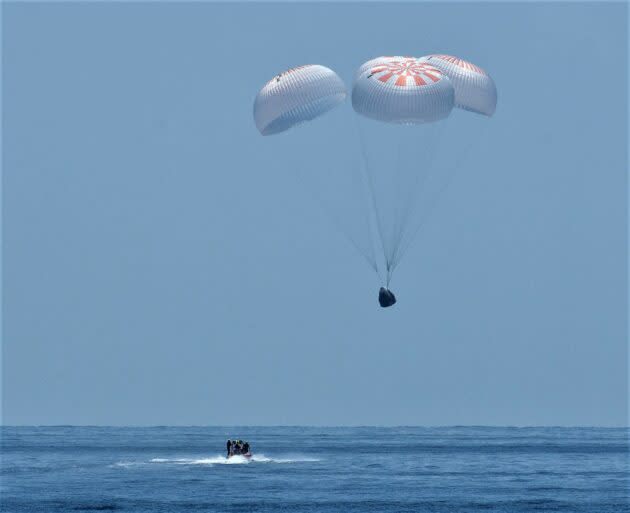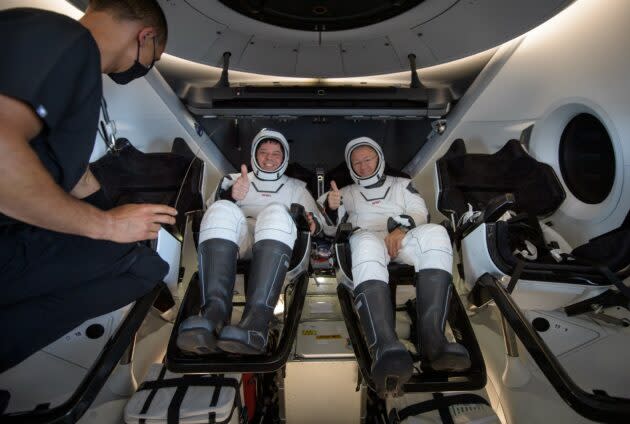NASA astronauts splash down in SpaceX Dragon capsule, capping historic mission

The first mission to send NASA astronauts into orbit on a commercially owned spaceship came back down to Earth today with the splashdown of a SpaceX Crew Dragon capsule in the Gulf of Mexico.
“On behalf of the SpaceX and NASA teams, welcome back to planet Earth, and thanks for flying SpaceX,” Mike Heiman, a lead member of SpaceX’s operations team, told astronauts Doug Hurley and Bob Behnken.
The splashdown closed out a 64-day mission to the International Space Station, aimed at testing the first SpaceX Dragon to carry crew. The reusable spacecraft, which put 27.1 million miles on its orbital odometer, was dubbed Endeavour as a tribute to earlier spaceships.
In May, Endeavour’s launch atop SpaceX’s Falcon 9 rocket made history, and today’s return to Earth did as well: It was the first time since 1975 that a crewed NASA spacecraft returned to Earth at sea, and the first space landing in the Gulf of Mexico.
The splashdown marked the completion of the first mission to launch astronauts into orbit from U.S. soil since NASA’s final space shuttle flight in 2011.
“This was a great day for NASA, and a great day for the United States of America,” NASA Administrator Jim Bridenstine said during a post-splashdown briefing. “Today we really made history. We are entering a new era of human spaceflight, where NASA is no longer the purchaser, owner and operator of all the hardware. We are going to be a customer — one customer of many customers.”
Hours later, at a celebratory ceremony in Houston, SpaceX CEO Elon Musk echoed Bridenstine’s view that the mission marked a new era. “We’re going to go to the moon, we’re going to have a base on the moon, we’re going to send people to Mars and make life multiplanetary,” he said.
Musk also thanked the teams at SpaceX and NASA for the successful end of what he clearly considered a high-stress mission. “I think my entire adrenaline just dumped,” he said with a nervous laugh. “Thank God! You know, I’m not very religious, but I prayed for this one.”
NASA and SpaceX chose a splashdown site off the coast of Pensacola on Florida’s Panhandle, rather than more easterly candidates, to stay far away from the track of Tropical Storm Isaias along Florida’s East Coast.
The storm wasn’t the only hazard that Hurley and Behnken faced: They had to rely on Endeavour’s thruster system to fire successfully for the descent from orbit, on its heatshield to protect them from the 3,500-degree Fahrenheit heat of atmospheric re-entry, and on its parachutes to make a safe landing amid the glassy Gulf waters.
A live video stream, watched online by more than half a million people, showed the four red-and-white main parachutes opening and the gumdrop-shaped spaceship hitting the water at 2:48 p.m. ET (11:48 a.m. PT).
About half an hour after the splashdown, Endeavour was hoisted aboard a ship called the Go Navigator with a crane. A flotilla of private vessels sailed through the landing zone, complicating the recovery effort and surprising mission managers.
“It’s something that we need to do better next time,” Bridenstine acknowledged. Gwynne Shotwell, SpaceX’s president and chief operating officer, said more Coast Guard, NASA and SpaceX assets will probably have to be in the landing area to keep boaters away for future splashdowns.

Once the Dragon was on the ship, SpaceX’s team conducted a purge of fumes around the Dragon’s hatch to make sure the astronauts wouldn’t be exposed to toxic fuel residues when they emerged. When the levels fell below limits, the hatch was opened, and Hurley and Behnken were helped out onto the ship’s deck. Both astronauts flashed thumbs-up as they were placed on stretchers — which is a traditional post-landing precaution.
“Thank you again from the Good Ship Endeavour,” Behnken told mission controllers.
Flight surgeons helped the astronauts readjust to Earth’s gravity after two months in zero-G. After an initial check on Go Navigator, Hurley and Behnken were taken to shore by helicopter, then flown back to their home base in Houston.
During this evening’s welcome-home ceremony at Houston’s Ellington Field, Hurley said he and Behnken had plenty of time to kill while they were waiting to be taken out of their capsule. “We were in a spaceship, bobbing around, making prank satellite phone calls to whoever we could get a hold of,” he joked. “Which was kind of fun, by the way.”
Before they left the station, both astronauts said they were most looking forward to reuniting with their families. And to whet their appetite for the reunion, this morning’s wakeup call came in the form of messages from their children. “Don’t worry, you can sleep in tomorrow,” Behnken’s 6-year-old son, Theo, told his dad.
Space dads @AstroBehnken and @Astro_Doug woke up aboard @SpaceX’s Dragon Endeavour to hear a message from their sons, awaiting the #LaunchAmerica crew’s arrival back on planet Earth. pic.twitter.com/ZhtZzpLYhu
— NASA (@NASA) August 2, 2020
The primary goal of this flight was to put the Dragon through its paces as a crewed spaceship, and by all accounts, it.passed all of its tests with flying colors.
For years, SpaceX worked under the terms of a multibillion-dollar contract with NASA to upgrade the Dragon capsule to carry astronauts safely to and from the space station. Boeing has a similar deal, but due to technical snags, its Starliner space taxi isn’t expected to be ready to carry crew until next year.
Dragon and Starliner are meant to fill a gap in crewed spaceflight capability left by the retirement of the space shuttle fleet in 2011. In the interim, NASA has had to pay the Russians as much as $80 million per seat to send U.S. astronauts on Soyuz capsules. SpaceX and Boeing say they’ll do the job for significantly less.
During their space station stay, Hurley and Behnken assisted the outpost’s three other crew members — NASA’s Chris Cassidy and Russia’s Anatoly Ivanishin and Ivan Vagner — with maintenance chores and science experiments. Behnken pitched in on four spacewalks with Cassidy to upgrade the station’s power system.
The next crewed SpaceX Dragon trip to the station is due for launch as soon as next month — and Behnken’s wife, NASA astronaut Megan McArthur, is on yet another Dragon crew heading for the station next spring. The same spacecraft that Behnken rode is destined to be refurbished for that flight.
